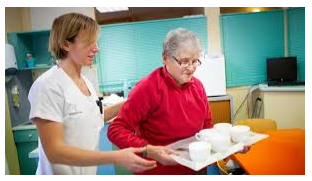Collaboration with Interdisciplinary Teams
Collaboration with Interdisciplinary Teams

In nursing practice, collaboration with interdisciplinary teams is a key component of providing safe and effective care. Nurses work alongside various healthcare professionals, including physicians, pharmacists, social workers, and more, to ensure that patients receive comprehensive, coordinated care. Effective collaboration among team members leads to improved patient outcomes, reduced errors, and more efficient healthcare delivery. This section explores the role of the nurse in coordinating care, the roles of other healthcare team members, strategies for effective communication and conflict resolution, and the importance of case conferences and multidisciplinary rounds.
Coordinating Care with Other Healthcare Professionals
1. Definition and Importance of Care Coordination
Coordinating care involves organizing patient care activities and sharing information among all participants concerned with a patient’s care to achieve safer and more effective outcomes. This process ensures that the patient’s needs are met efficiently across the healthcare continuum.
Nurse’s Role in Coordinating Care:
- Central Coordinator: Nurses often act as the central hub for communication between the patient and various healthcare providers. This role involves synthesizing information from all team members and ensuring that the care plan is cohesive and aligned with the patient’s needs.
- Care Transitions: Nurses facilitate transitions between different levels of care, such as from hospital to home or from acute care to rehabilitation facilities. This coordination helps prevent gaps in care and reduces the risk of readmissions.
- Patient Advocacy: Nurses advocate for the patient by ensuring their preferences and needs are communicated to all members of the healthcare team. This includes voicing concerns about treatment plans that may not align with the patient’s wishes.
2. Roles of Different Healthcare Team Members
Effective care coordination requires a comprehensive understanding of the roles and responsibilities of other healthcare professionals. Nurses work with a wide range of team members, each contributing unique expertise.
a) Physicians

- Role: Physicians are responsible for diagnosing conditions, developing treatment plans, and prescribing medications. They are typically the leaders of the medical team and rely on input from other healthcare professionals to ensure the patient’s care plan is both effective and safe.
- Collaboration with Nurses: Nurses are often the first to notice changes in a patient’s condition and communicate these to the physician. This collaboration is crucial in preventing adverse outcomes. Additionally, nurses implement many physician-ordered interventions, such as medication administration and treatments, and must ensure that they are carried out as prescribed.
b) Pharmacists

- Role: Pharmacists play a critical role in ensuring the safe and effective use of medications. They provide expertise on drug interactions, side effects, dosing, and contraindications.
- Collaboration with Nurses: Nurses and pharmacists work together to ensure the proper administration of medications. Nurses rely on pharmacists to clarify complex medication regimens, manage adverse drug reactions, and ensure that medications are administered according to evidence-based protocols.
c) Social Workers

- Role: Social workers assist patients with navigating the healthcare system, including addressing social determinants of health such as housing, transportation, financial support, and access to community resources.
- Collaboration with Nurses: Nurses and social workers collaborate to ensure that the patient’s psychosocial needs are met. Social workers provide vital support during discharge planning, especially for patients with complex needs who require ongoing community services.
d) Physical Therapists (PTs)

- Role: PTs focus on improving a patient’s mobility, strength, and functional abilities. They develop rehabilitation plans to help patients recover from injuries or surgeries and manage chronic conditions.
- Collaboration with Nurses: Nurses often communicate with PTs regarding the patient’s mobility status and ability to participate in therapy sessions. Nurses also assist with implementing mobility interventions, such as transferring patients or ambulating them, in collaboration with PTs.
e) Occupational Therapists (OTs)

- Role: OTs help patients improve their ability to perform activities of daily living (ADLs) such as dressing, eating, and bathing. They focus on enhancing patients’ independence and quality of life.
- Collaboration with Nurses: Nurses and OTs work together to ensure that patients are able to safely perform ADLs. Nurses may assist with activities recommended by OTs and provide feedback on the patient’s progress or challenges.
f) Dietitians

- Role: Dietitians are responsible for assessing patients’ nutritional needs and developing dietary plans to promote health and manage disease.
- Collaboration with Nurses: Nurses work with dietitians to ensure that patients are receiving appropriate nutrition, particularly in cases of malnutrition, special dietary needs (e.g., diabetes), or during recovery from surgery or illness.
g) Respiratory Therapists (RTs)

- Role: RTs specialize in the care of patients with respiratory conditions, providing treatments such as oxygen therapy, mechanical ventilation, and nebulization.
- Collaboration with Nurses: Nurses and RTs collaborate to ensure that patients with respiratory issues receive appropriate care. Nurses are responsible for monitoring respiratory status and administering RT-recommended treatments.
h. Case Managers

- Role: Case managers coordinate the patient’s overall care plan, focusing on managing resources, insurance issues, and facilitating discharge planning.
- Collaboration with Nurses: Case managers work closely with nurses to identify patient needs and create plans that ensure safe and efficient transitions between different levels of care.
Effective Communication and Collaboration Strategies
Effective communication is essential for safe patient care. Miscommunication or lack of communication among healthcare providers is a leading cause of medical errors. Nurses must utilize strategies that promote clear, open, and respectful communication among team members.
i. SBAR Communication Technique
The SBAR (Situation, Background, Assessment, Recommendation) technique is widely used in healthcare to standardize communication. It helps ensure that vital information is conveyed in a concise and structured manner.
- Situation: What is happening with the patient?
Example: “The patient is experiencing chest pain that started 30 minutes ago.”
- Background: What is the clinical background or context?
Example: “The patient has a history of coronary artery disease and recently underwent a stent placement.”
- Assessment: What do you think the problem is?
Example: “The patient may be experiencing a cardiac event.”
- Recommendation: What would you suggest?
Example: “I recommend we perform an ECG and notify the cardiologist immediately.”
ii. TeamSTEPPS
Team Strategies and Tools to Enhance Performance and Patient Safety (TeamSTEPPS) is a framework aimed at improving teamwork and communication in healthcare. The five key principles include:
- Team Structure: Clearly defining roles and responsibilities.
- Communication: Using structured communication tools like SBAR.
- Leadership: Having clear team leadership that facilitates collaboration.
- Situation Monitoring: Regularly assessing the situation to identify changes.
- Mutual Support: Providing support to team members when needed.
iii. Active Listening

Active listening is crucial in healthcare communication. Nurses must actively listen to their colleagues’ concerns, ideas, and observations to foster a collaborative environment. This involves:
- Maintaining eye contact and appropriate body language.
- Acknowledging the speaker’s points through verbal affirmations.
- Clarifying any misunderstandings through open-ended questions.
iv. Use of Technology for Communication
- Electronic Health Records (EHRs): EHRs provide a centralized platform for healthcare professionals to document patient information and communicate critical data. Nurses must ensure that EHRs are up-to-date, accurate, and shared with all relevant team members.
- Telemedicine and Remote Communication: Increasingly, healthcare teams are using telemedicine to collaborate across distances. Nurses may participate in virtual meetings or consultations to ensure that care is coordinated effectively.
Conflict Resolution within the Healthcare Team

Conflicts can arise in any healthcare setting due to differing opinions, unclear communication, or misaligned goals. Effective conflict resolution is essential for maintaining a positive working environment and ensuring patient safety.
i. Common Sources of Conflict
- Role Confusion: Unclear boundaries or overlapping roles can lead to frustration among team members.
- Communication Breakdown: Miscommunication or lack of communication can cause misunderstandings or errors in patient care.
- Differing Clinical Opinions: Healthcare professionals may have different approaches to patient care, which can result in disagreements about the best course of action.
- Resource Allocation: Competition for limited resources, such as time, equipment, or staff, can lead to tension among team members.
ii. Conflict Resolution Strategies
- Open Dialogue: Encourage open and honest communication between team members to identify the source of the conflict and work towards a solution.
- Mediation: A neutral third party, such as a nurse manager or case manager, can mediate conflicts and help team members reach a consensus.
- Compromise: In some cases, team members may need to compromise to find a solution that benefits the patient and resolves the conflict.
- Respect for Expertise: Recognizing and respecting the expertise and perspectives of each team member can help prevent conflicts. Each healthcare professional brings valuable knowledge and experience to the table.
iii. The Nurse’s Role in Conflict Resolution
Nurses often serve as intermediaries when conflicts arise. They must:
- Facilitate communication between team members to clarify misunderstandings.
- Advocate for the patient’s best interests, ensuring that conflicts do not negatively impact patient care.
- Remain calm and objective, using de-escalation techniques to defuse tense situations.
Case Conferences and Multidisciplinary Rounds
Case conferences and multidisciplinary rounds (MDRs) are structured meetings where healthcare professionals collaborate to discuss patient care, share insights, and develop comprehensive treatment plans.
i. Definition and Purpose of Case Conferences
A case conference is a formal meeting involving healthcare professionals, the patient, and often the patient’s family to discuss complex cases. The purpose is to coordinate care, evaluate the patient’s progress, and adjust the care plan as needed.
Benefits of Case Conferences:
- Holistic Care Planning: Case conferences allow the team to approach the patient’s care from multiple angles, ensuring that all aspects of their health are addressed.
- Improved Communication: Regular meetings foster clear communication and help prevent misunderstandings among team members.
- Increased Patient Involvement: Case conferences often include the patient and their family, allowing them to participate in decision-making and voice their concerns.
ii. Multidisciplinary Rounds (MDRs)
MDRs are regular, structured rounds in which healthcare professionals from different disciplines meet to discuss the care of patients, especially those with complex needs. These rounds typically occur at the bedside, allowing for real-time assessment and planning.
Key Elements of Effective MDRs:
- Inclusive Team Participation: All relevant team members, including nurses, physicians, pharmacists, social workers, and others, should be present to provide input.
- Patient and Family Involvement: When possible, the patient and their family should participate in MDRs to ensure that their preferences are incorporated into the care plan.
- Focus on Patient-Centered Care: The discussion should be centered around the patient’s goals, needs, and outcomes, rather than the individual preferences of healthcare providers.
iii. Nurse’s Role in Case Conferences and MDRs
- Advocate for the Patient: Nurses play a key role in ensuring that the patient’s needs and preferences are represented during case conferences and MDRs.
- Provide Clinical Insights: Nurses spend the most time with patients and often have the most up-to-date information about their condition. This insight is invaluable during discussions of the care plan.
- Facilitate Communication: Nurses help to bridge gaps between different healthcare professionals by ensuring that all relevant information is communicated clearly and that team members are on the same page regarding the care plan.
Conclusion
Collaboration with interdisciplinary teams is fundamental to providing safe, high-quality patient care. Nurses play a central role in coordinating care, facilitating communication, resolving conflicts, and participating in case conferences and multidisciplinary rounds. By understanding the roles of other healthcare professionals and employing effective communication strategies, nurses can help ensure that patients receive the best possible care. Additionally, nurses’ ability to advocate for their patients and participate in collaborative decision-making processes contributes to improved patient outcomes and a more efficient healthcare system.
